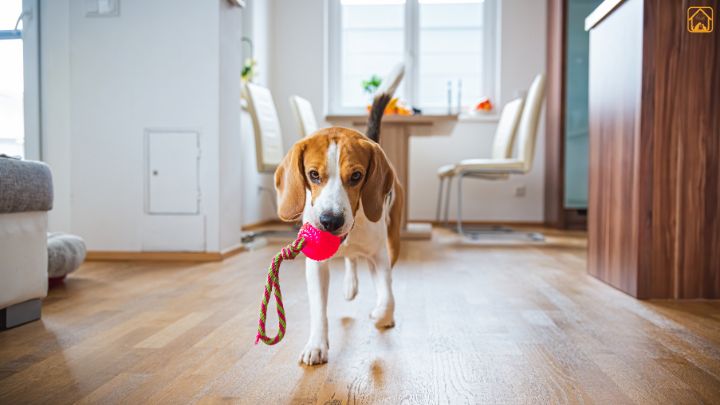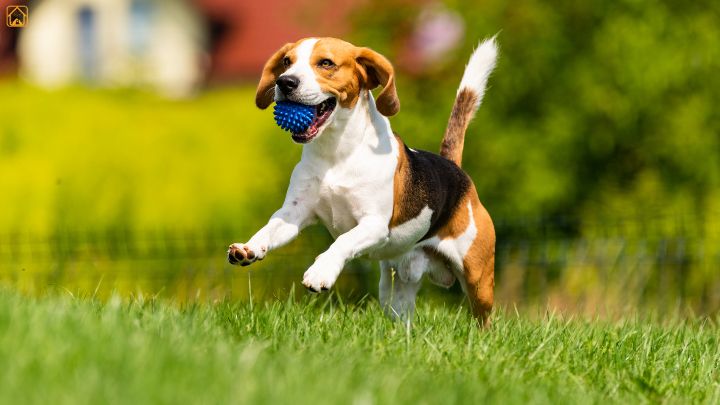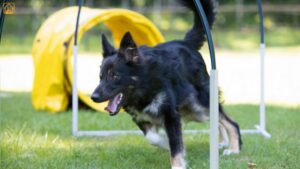Why Dog Exercise Matters: Health, Behaviour, and the Human-Canine Bond
Dogs aren’t just active by nature, they need movement to stay balanced. Exercise isn’t just about burning off steam; it’s about helping your dog feel better, behave better, and live longer. Give your dog a good workout, and you’ll see a calmer, happier pup.
- Physical Health: Exercise helps manage weight, keeps joints flexible, and strengthens muscles. It lowers the risk of diabetes, arthritis, and heart problems. Dogs who move more tend to live longer, fuller lives.
- Behaviour: Ever dealt with chewed shoes or relentless barking? Often, its pent-up energy. Top dog exercises provide an outlet, reducing anxiety, boredom, and unwanted behaviours.
- The Bond: There’s nothing like the connection built during a walk, run, or training session. You become their favorite teammate, and their world feels safer and more fun.
I remember when my own rescue pup started relaxing more and listening better after adding a daily game of tug. It was like flipping a switch, she just needed that extra playtime.
How Much Exercise Does Your Dog Really Need? (By Age, Breed & Health)
Not all dogs are born marathoners. Your pup’s ideal routine depends on their age, breed, and health. Wondering how much exercise does my dog need? Here’s a quick guide:
| Life Stage/Breed | Recommended Exercise |
| Puppies | Frequent, short play sessions (5-10 min per month of age, up to twice a day). Avoid long runs or jumps to protect growing joints. |
| Adults (Most Breeds) | 30-90 minutes daily, split between walks, play, and training. |
| High-Energy Breeds (Border Collie, Lab, Aussie) | 1-2 hours or more. Includes runs, fetch, agility, and brain games. |
| Brachycephalic/Small Breeds | 20-40 minutes, gentle walks and play. Watch for signs of overheating. |
| Seniors | Short, gentle walks and low-impact play. Focus on joint safety and comfort. |
Remember: Dog exercise requirements by breed can vary wildly. If you have doubts, ask your trusted trainer for personalized advice.
- Puppy exercise requirements are lower, but more frequent play prevents zoomie chaos.
- Senior dog workout routines should focus on mobility, not intensity.
- Weight loss exercises for overweight dogs should be slow and steady, think short walks, swimming, or gentle play.
Top 10 Dog Exercises: Fun Workouts for Body and Mind
- Walking: Every dog’s daily staple. Adjust pace and length for your pup’s needs.
- Running/Jogging: Great for dogs with stamina. Start slow, watch for fatigue.
- Fetch: Simple, effective, and endlessly fun. Try fetching with balls, sticks, or frisbees.
- Tug-of-War: Builds muscle and self-control. Remember, you’re still in charge, even during play.
- Swimming: Low-impact, full-body workout. Perfect for dogs with joint issues or those needing extra exercise without stress on their bodies.
- Agility Training: Set up a backyard course or use a dog exercise pen with top for safety. Teaches confidence and sharpens reflexes.
- Stair Climbing: Easy way to add cardio indoors. Just a few flights can tire out most pups.
- Obstacle Walks: Use park benches, logs, or cones to create mini-challenges on walks.
- Hide and Seek: Hide treats or toys for your dog to find. Mental and physical exercise rolled into one.
- Dog Dancing/Trick Training: Combine music, movement, and fun tricks. It feels silly, but trust me, it’s a workout!
Try rotating these top dog exercises to keep things interesting. I once tried dog dancing with my retriever, and yes, we both looked goofy, but we laughed the whole time. That memory sticks with me every time I see her tail wag at music.
Indoor & Apartment-Friendly Dog Exercises: Beat Weather and Space Limits

How to Exercise Your Dog in an Apartment?
No yard? No problem. There are plenty of exercises to do with your dog at home. Here’s how to keep your dog fit, even with space or weather limits:
- Stair Sprints: If you have stairs, use them for quick bursts of energy.
- Interactive Toys: Puzzle feeders, treat-dispensing balls, and snuffle mats provide both movement and mental stimulation.
- Tug-of-War & Fetch: Use soft toys and play in a hallway or living room.
- Dog Exercise Pen with Top: Great for safe play and short training drills indoors.
- Training Sessions: Practice obedience, tricks, or agility basics. Mental stimulation games for dogs can be just as tiring as a walk.
Best Daily Dog Exercises for Every Lifestyle: Walks, Runs & Play
Classic Walks: The Foundation of Fitness
Walking is the backbone of any dog fitness routine. It’s gentle, adaptable, and great for bonding. Even 20-30 minutes a day can make a huge difference. Plus, walks are a chance for your dog to sniff and explore, which is mental exercise too.
- Change routes for more excitement
- Let your dog lead with their nose during “sniff walks”
Running & Jogging: For High-Energy Dogs
If you’ve got a bundle of energy with four legs, try running together. Start slow, especially with young or overweight dogs. Use a hands-free leash for safety. Not all breeds are built for distance, so always check your pets’ health.
Playtime Essentials: Fetch, Tug-of-War & More
- Fetch: Classic, calorie-burning, and easy to play in most spaces. Use balls or frisbees. For fetch alternatives for active dogs, try rolling toys or using a flirt pole.
- Tug-of-War: Builds muscle, teaches impulse control, and strengthens your bond. My own dog lights up when she sees the tug toy, it’s her favorite workout.
- Agility & Obstacle Courses: Set up jumps, tunnels, or weave poles in the yard. Even simple DIY setups spark excitement.
Mix these up throughout the week to keep your dog engaged. If you need lazy ways to exercise your dog, try scatter-feeding kibble in the yard or using interactive toys that promote movement.
Low Impact & Senior Dog Workouts: Safe Routines for Older Pups
Gentle Moves for Aging Joints
Senior dogs still need movement, but gentler is better. Low impact exercises for dogs, like slow walks, swimming, or light tug games, help maintain mobility without stressing joints.
- Short, frequent walks on soft surfaces
- Gentle play with plush toys
- Hydrotherapy or swimming if available
- Simple stretching and massage
Always warm up with a gentle stroll before adding in any new activity. My neighbor’s old Beagle comes alive during slow swimming sessions, it’s like a second puppyhood. Just keep sessions short and always watch for signs of soreness.
Building Muscle & Agility Training for Dogs
Want to help your dog build strength, not just burn calories? Try these dog fitness exercises:
Dog Exercise for Muscle & Energy
- Hill or Resistance Walks: Walking uphill or on sand builds muscle and stamina.
- Agility Courses: Jumps, tunnels, and weave poles improve coordination and core strength.
- Tug-of-War & Weighted Backpacks: Short sessions with safe, light packs can add resistance.
- Stair Climbing: Short bursts up and down stairs build leg and core muscles.
- Dog Topline Exercises: These focus on developing the back and neck muscles, think “stand and hold,” “back up,” or slow, controlled trotting.
Mental Stimulation: Games and Training Exercises for a Sharper Dog
Physical exercise is only half the story. Dogs crave brain work, too. Without it, boredom can lead to mischief.
- Puzzle Toys: Hide treats in snuffle mats or puzzle feeders.
- Training Drills: Practice sits, stays, and recall, add new tricks for a challenge.
- Scent Games: Hide treats around the house and let your dog sniff them out.
- Dog Agility Training at Home: Even a line of chairs or broomsticks can become a fun course.
I love watching my dog’s ears perk up when we play “find it.” Mental games can tire out even the most energetic pup.
Dog Exercise Safety: Tips, Precautions & Seasonal Advice
How to Exercise Your Dog Safely
- Always start slow, especially with new routines or after a break.
- Check for signs your dog needs more exercise, restlessness, barking, or unwanted chewing.
- Bring water, avoid hot pavement, and exercise early or late in summer. For winter, consider booties and wipe paws after walks.
- Don’t force exercise if your dog seems tired, stiff, or overheated.
- Consult your vet before starting new, intense routines, especially for puppies, seniors, or dogs with health issues.
Honestly, I learned the hard way about hot sidewalks, my dog once limped after a summer walk. Now, I always check the pavement with my hand first. Safety first, always.
Conclusion
Ready to get moving? Build your own dog exercise routine with these tips, and watch your pup thrive, body and mind. For more, check out our guides on indoor dog exercises, outdoor dog exercises, exercises for dogs with health issues. Your dog will thank you with extra tail wags and happy zoomies.



